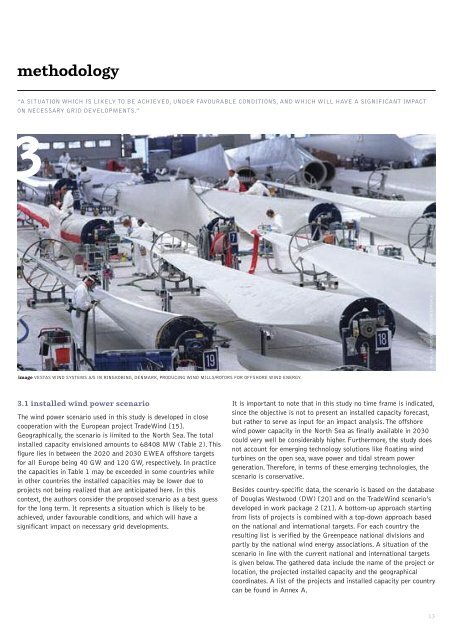offshore grids for wind power integration - Greenpeace
offshore grids for wind power integration - Greenpeace
offshore grids for wind power integration - Greenpeace
Create successful ePaper yourself
Turn your PDF publications into a flip-book with our unique Google optimized e-Paper software.
methodology<br />
“A SITUATION WHICH IS LIKELY TO BE ACHIEVED, UNDER FAVOURABLE CONDITIONS, AND WHICH WILL HAVE A SIGNIFICANT IMPACT<br />
ON NECESSARY GRID DEVELOPMENTS.”<br />
3<br />
© PAUL LANGROCK/ZENIT/GREENPEACE<br />
image VESTAS WIND SYSTEMS A/S IN RINGKOBING, DENMARK, PRODUCING WIND MILLS/ROTORS FOR OFFSHORE WIND ENERGY.<br />
3.1 installed <strong>wind</strong> <strong>power</strong> scenario<br />
The <strong>wind</strong> <strong>power</strong> scenario used in this study is developed in close<br />
cooperation with the European project TradeWind [15].<br />
Geographically, the scenario is limited to the North Sea.The total<br />
installed capacity envisioned amounts to 68408 MW (Table 2).This<br />
figure lies in between the 2020 and 2030 EWEA <strong>offshore</strong> targets<br />
<strong>for</strong> all Europe being 40 GW and 120 GW, respectively. In practice<br />
the capacities in Table 1 may be exceeded in some countries while<br />
in other countries the installed capacities may be lower due to<br />
projects not being realized that are anticipated here. In this<br />
context, the authors consider the proposed scenario as a best guess<br />
<strong>for</strong> the long term. It represents a situation which is likely to be<br />
achieved, under favourable conditions, and which will have a<br />
significant impact on necessary grid developments.<br />
It is important to note that in this study no time frame is indicated,<br />
since the objective is not to present an installed capacity <strong>for</strong>ecast,<br />
but rather to serve as input <strong>for</strong> an impact analysis.The <strong>offshore</strong><br />
<strong>wind</strong> <strong>power</strong> capacity in the North Sea as finally available in 2030<br />
could very well be considerably higher. Furthermore, the study does<br />
not account <strong>for</strong> emerging technology solutions like floating <strong>wind</strong><br />
turbines on the open sea, wave <strong>power</strong> and tidal stream <strong>power</strong><br />
generation.There<strong>for</strong>e, in terms of these emerging technologies, the<br />
scenario is conservative.<br />
Besides country-specific data, the scenario is based on the database<br />
of Douglas Westwood (DW) [20] and on the TradeWind scenario’s<br />
developed in work package 2 [21]. A bottom-up approach starting<br />
from lists of projects is combined with a top-down approach based<br />
on the national and international targets. For each country the<br />
resulting list is verified by the <strong>Greenpeace</strong> national divisions and<br />
partly by the national <strong>wind</strong> energy associations. A situation of the<br />
scenario in line with the current national and international targets<br />
is given below.The gathered data include the name of the project or<br />
location, the projected installed capacity and the geographical<br />
coordinates. A list of the projects and installed capacity per country<br />
can be found in Annex A.<br />
13

















